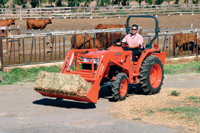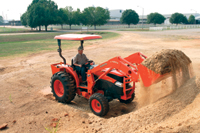Tractor TLC
Well-oiled machines need constant attention to continue to work hard. Versatile equipment like compact tractors work in a myriad of unique applications that take a toll on the iron parts, lubricated joints, vulcanized wheels and electronic systems of your landscape and construction machines.

Proper maintenance is an ongoing investment that improves the performance and prolongs the lifespan of machinery. Just like you wouldn’t plant a tree, deprive it of water and sunlight and expect it to grow, it is unreasonable to deny equipment necessary maintenance and expect optimum performance.
Misuse Is All Too Common
The two most common service issues seen on a regular basis are lack of routine maintenance and product failures resulting from misapplication, but both are easy to prevent.
Lack of routine maintenance, such as normal oil and filter changes as outlined in the operator’s manual, can severely damage even the best machine. Therefore, operators must take the initiative to practice regular maintenance of their products to maximize the machine’s lifespan and ensure consistent operation.
Many times the operator and owner of a given machine is not the same individual, so it is important that all operators review the operator’s manual. In addition, it’s a good practice to assign individual responsibilities for various aspects of regular maintenance, including daily lubrication and walk-around checks.
The second most common service issue is machine failure as a result of misapplication. When shopping for a new piece of equipment it is essential to purchase based on suitability for the job rather than based on price alone. Too often machines are used for jobs they weren’t designed for, resulting in over-stressed components and early failures. Matching the machine to the job will go a long way in preventing costly repairs.
Leave It to the Professionals
Like many manufacturers, Kubota recommends all service be performed by an authorized dealer, to ensure only qualified technicians work on your machine. These technicians are familiar and well trained on your equipment. Service expertise and support, attention to your individual needs and use of only authorized genuine parts are the reasons.
10 Easy Steps to Tractor LongevityCompiled by CE Staff
It is okay to leave last season’s oil in the system during the winter, if you are not going to be using your equipment, but be sure to change it before its first use this spring. Oil is vital for many functions, including lubrication of all the working engine parts, prevention of corrosion, protection against rust and wear and maintaining a clean engine. 2. Check Hydraulic, Transmission and Rear End Case Fluid Levels A tiny bit of dirt can ruin the hydrostatic transmission or the hydraulic cylinder seals, so you will want to check your hydraulic system. Wipe off the filler cap and filler tube. Then refill the hydraulic system carefully. 3. Clean or Replace Filters Because the spring and summer seasons are often dry and dusty, you should also change your tractor’s air filter. Check the fuel filters and oil filters and, when applicable, you’ll want to check your hydraulic system filters. Go ahead and change any filters that appear dirty as it is just good preventive maintenance and is cost-efficient overall. 4. Do Not Overlook the Battery Test each battery cell’s electrolyte level with a hydrometer. If necessary, recharge or replace the battery. 5. Check Safety Features Check brakes and brake pads to make certain they are not slipping or grabbing. Check tires to guarantee they are properly inflated and inspect all lights to make sure they are working properly. 6. Inspect Cable Connections Check the spark plugs and change them, if needed. Pay special attention to glow plugs, if applicable. Make sure all starter connections are secure and haven’t corroded. Tighten any loose connections, but be careful not to over tighten. Do the same for the generator and modify the tension in the driving belt. 7. Make Sure the Engine Is Adequately Lubricated Engine lubrication guidelines will be found in your equipment owner’s manual. If you don’t have a copy of your manual, now’s a good time to pick up another at your dealer, so you’ll have it handy when the heavy work starts. 8. Flush and Clean the Radiator If you didn’t flush the radiator last fall, do so this spring. Also, gently vacuum or blow out debris that may restrict air flow from the radiator coils. 9. Tighten and Repair Loose Bolts and Fix Leaks Tighten wheel lugs and re-torque to the manufacturer’s recommendations. Check for loose bolts, leaks, worn belts, hoses and listen for any suspicious rattles to guarantee your safety, as well as the reliability of your equipment. 10. Clean and Restore Attachments Clean all attachments of any debris from last season. Clean all scraper blades. Sharpen the cutting blade on any mowing equipment at the beginning of spring, then again before the first mowing. Check any other attachments and implements. Clean and lubricate as necessary. Inspect for and remove any rust, then re-touch as needed. |
Five Simple Rules
Follow these five rules of routine maintenance in order to avoid issues with your trusty machine:
1. Make sure to read the operator’s manual, including literature covering the attachments. Know how to safely operate the equipment and its operational limitations.
2. Do daily walk-around checks for maintenance items such as oil levels, tire air pressures, wheel lug nut torque, air filter condition, coolant levels and radiator blockage with grass, dirt, etc. This will help catch maintenance needs before they turn into problems — it’s all about being proactive.
3. Perform regular maintenance at or before the manufacturer’s recommendations, avoiding aftermarket oils and filters. Use only the correct fuel and never fuel your machine while it is running.
4. Operate the equipment within the conditions it was designed for. For example, a farm tractor with a front loader is not a bulldozer. A farm tractor with a rotary cutter is not a stump grinder or a tree harvester.
5. Get to know your local authorized dealer. They have factory trained technicians and OEM (original equipment manufacturer) parts to properly service the equipment for long dependable operation.
Seasonal Maintenance

There are a few simple precautions that must be taken. First, be sure to keep the machine and supply of fuel in locked storage and remove the ignition key to prevent children or others from playing or tampering with them. Always disconnect the battery’s ground cable (negative terminal) first and reconnect it last. Do not store a machine with fuel in the tank inside a building where fumes may ignite. Never operate a machine inside a building without proper ventilation to avoid exhaust fume poisoning.
If your machinery is required to be stored for longer periods of time, there are additional procedures that should be considered. Always check for loose bolts and nuts before placing the machine in storage and tighten if necessary, remembering to also apply grease to pivot areas and places where bare metal will rust. Inflate the tires to a pressure a little higher than usual to make up for the inevitable tire pressure loss during storage. Change the engine oil and remove the battery from the machine. Keeping the machine in a dry place is important.
For more maintenance information, please visit the “Support” section on www.kubota.com or feel free to speak with your local dealer for additional maintenance tips and recommendations
Ray Schroth is the director of service at Kubota Tractor Corp., based on Torrance, Calif.


 1. Never Extend Oil Life Past One Year
1. Never Extend Oil Life Past One Year
Comments are closed here.